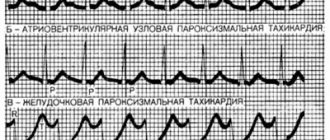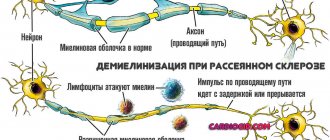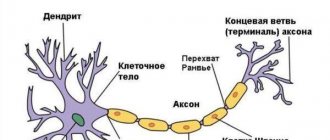| Panic disorder | |
| ICD-10 | 41.041.0 |
| ICD-9 | 300.01300.01, 300.21300.21 |
| OMIM | 167870, 607853 and 609985 |
| DiseasesDB | 30913 |
| MedlinePlus | 000924 |
| MeSH | D016584 |
Panic disorder
or
episodic paroxysmal anxiety
is a mental disorder characterized by the spontaneous occurrence of panic attacks several times a year to several times a day and the anticipation of their occurrence. A characteristic feature of the disorder is recurrent attacks of severe anxiety (panic), which are not limited to a specific situation or circumstances and, therefore, unpredictable[1].
Another name for this disease is episodic paroxysmal anxiety.
.
Before the widespread use of ICD-10, this disease, depending on the leading symptom, was called differently: “cardioneurosis”, “VSD (vegetative-vascular dystonia) with a crisis course”, “NCD (neurocirculatory dystonia)”
.
Clinical picture and diagnostic criteria
People with panic disorder typically experience a series of intense episodes of extreme anxiety called panic attacks. Panic attacks usually last about 10 minutes, but can be short-term - about 1-5 minutes, and long-lasting - up to 30 minutes, while the feeling of anxiety can persist for 1 hour. Panic attacks can vary in the set of symptoms or be of the same type (that is, tachycardia, sweating, dizziness, shortness of breath, tremors, experiencing uncontrollable fear, etc.). In some patients, these conditions are observed regularly - sometimes daily or weekly. The external symptoms of a panic attack often lead to negative social consequences (eg, embarrassment, social stigma, social isolation). However, patients who are aware of their illness can often have intense panic attacks with very little external manifestations of this condition.
A special scale is used to determine the severity of panic disorder; it also exists in the form of a self-esteem questionnaire as a test for panic attacks[2][3].
Diagnostic criteria ICD-10
- Repeated, unpredictable attacks (not limited to any specific situation) of severe anxiety (panic).
- Autonomic pain symptoms accompanying anxiety, derealization and depersonalization.
- Secondary fears of death and madness.
- Secondary avoidance of any situation in which the panic attack first occurred.
- Secondary fears of loneliness, crowded places, repeated panic attacks.
- Panic disorder is the primary diagnosis in the absence of any phobia as a primary disorder ( otherwise, a panic attack is considered a sign of a full-blown phobia
). - A reliable diagnosis of panic disorder requires that several severe anxiety attacks
observed at least
within one month
and met the following requirements:- Panic disorder occurs under circumstances not related to an objective threat ( anxiety of anticipating an attack is possible
). - Panic disorder is not limited to a known, predictable situation.
- Availability of anxiety-free periods between attacks.
DSM-IV Diagnostic Criteria
- A.
- Recurrent panic attacks.
- At least one attack occurred for 1 month (or more) with the following additional symptoms:
- Continued concern about seizures.
- Worry about the consequences of the attack (for example, fear of loss of self-control, myocardial infarction, fear of going crazy).
- Significant changes in behavior associated with attacks.
- B. Presence (or absence) of agoraphobia.
- C. Symptoms are not due to direct physiological effects of a substance (eg, drug abuse, medication) or a medical condition (eg, hypertension, hyperthyroidism, pheochromocytoma, etc.).
- Symptoms cannot be explained by the presence of another mental or behavioral disorder, such as somatoform autonomic dysfunction of the heart and cardiovascular system, hypochondriasis, social phobia, other phobias, obsessive-compulsive disorder, post-traumatic stress disorder, or separation anxiety disorder.
According to the Diagnostic and Statistical Manual DSM-IV-TR, panic attacks are not considered as a separate disease, but are coded as part of the diagnosis of other anxiety disorders[4].
Differential diagnosis
Panic disorder must be distinguished from a number of somatic diseases and conditions, which include cardiovascular disorders, chronic obstructive pulmonary diseases, some endocrine and metabolic disorders (Cushing's disease, electrolyte disorders, hyperthyroidism, hyperglycemia, diseases of the parathyroid glands), epilepsy, especially temporal; peptic ulcer, pheochromocytoma, pulmonary embolism[5], vestibulopathies, central nervous system tumors, bronchial asthma, effects of certain drugs and narcotic substances[6], conditions after severe burns and extensive surgical interventions. As well as from mental illnesses and disorders that may be accompanied by panic attacks - for example, established phobic disorders (F40.x), post-traumatic stress disorder, obsessive-compulsive disorder, somatoform disorders (F4x.x) and other similar disorders. Panic attacks may be secondary to depressive anxiety spectrum disorders, especially in men, and if criteria for depressive disorder are met, panic disorder should not be established as the primary diagnosis.
What is panic disorder?
Panic disorder is a condition in which a person suddenly experiences episodes of intense fear or anxiety, often without warning. Imagine, say, that one fine day you arrive at work and get out of the car. Suddenly you suddenly feel a tightness in your chest. Your heart begins to pound furiously, your head begins to spin, and at the same time you periodically lose consciousness. Plus, you're out of breath. In general, it feels like you are dying. Does all this really happen purely in your head? But no. Most likely, you are experiencing a panic attack.
A panic attack can last from a few minutes to several hours. Moreover, they can occur either once every few years or much more often. The cause or trigger of a panic attack is difficult to determine. That is why its diagnosis is carried out after at least 2 episodes that arose out of the blue and were subsequently accompanied by a feeling of anxiety about a possible recurrence for at least 1 month. Without proper treatment, panic attacks can lead to the development of phobias.
What is a phobia?
A phobia is a pronounced, inexplicable fear of some object or phenomenon. There are hundreds of different phobias, including fear of crowds, bridges, snakes, spiders, heights, open spaces or public speaking.
At the same time, a phobia is considered a problem only if it prevents a person from leading a normal life. For example, people often refuse to leave home due to one of the above phobias.
Course and prevalence
Panic disorder usually begins at a young age, less often in childhood and adulthood. According to research results, about 1.7% of the US adult population had symptoms of panic disorder (women are 2-3 times more likely to get sick). The disease has a wavy course; about half of the patients generally recover, the rest lead a relatively normal life, despite the persistence of symptoms and the presence of relapses.
The protracted course of panic disorder is facilitated by inadequate and untimely treatment measures. Anxiety disorders, including panic, are diagnosed in only 50% of patients with obvious symptoms. Fewer than 50% of patients receive any treatment and less than 30% receive adequate therapy.
Causes
In cases where psychiatrists at our clinic identify mental disorders accompanied by fears and anxiety, they try to find the main factor provoking the condition. Then the task of relieving the client of his illness becomes much simpler.
Most often, the development of the process is provoked by:
- The presence of similar suffering in relatives (heredity factor).
- Childhood and adolescent psychotrauma.
- Increased level of sensitivity and conflict in the individual.
- Features (accentuations) of the patient’s character and temperament. High background anxiety, suspiciousness, excessive impressionability, vulnerability, frequent impulsive reactions, shyness.
- Staying under stress for a long time.
- Falling under the influence of super-strong emotions, both negative and positive.
- Diagnosis of a serious illness.
- Physical limitations due to disability.
- Hormonal disorders (diabetes mellitus, thyroid pathologies, etc.)
- Neuroses and phobias.
Panic states are frequent companions of people with an unbalanced diet, suffering from chronic fatigue, lack of sleep and use of psychoactive substances.
Treatment
Despite the obligatory presence of autonomic dysfunction in an attack and the often implicit nature of emotional disorders, the main methods of treating panic disorders are psychotherapy and psychopharmacology. SSRI antidepressants (fluoxetine, paroxetine) are used long-term, for at least 6 months, and tranquilizers (alprazolam, clonazepam), for a short course - up to 14 days.
For some time, highly potent benzodiazepines such as alprazolam and clonazepam were considered the first choice drugs for the treatment of panic disorder. But their lack of effectiveness against symptoms of depression, which often co-occurs with panic attacks, and significant side effects have reduced their popularity. SSRIs have become the first-line drugs of choice.[5]
In patients with a history of manic states, the use of benzodiazepines is preferable, since, unlike antidepressants, they do not provoke mania[6].
The use of so-called vegetotropic drugs (anaprilin, pyrroxan, belloid, bellaspon) in combination with vascular-metabolic therapy (cinnarizine, cavinton, trental, nootropil, piracetam, cerebrolysin) is ineffective, which undermines faith in the possibility of a cure and contributes to the chronicity of the disease.
Not all classes of psychotropic medications are equally effective against panic. With the right approach, panic disorder is highly treatable. An individual treatment plan is required for each patient, which should be developed by the patient together with his attending physician.
Cognitive behavioral therapy has been proven effective in treating panic disorder[5][6][7]. From the point of view of psychoanalysis, the main cause of panic disorder is considered to be repressed psychological conflicts that do not find a way out and cannot be recognized and resolved by a person due to various reasons. With the help of a psychotherapist or psychologist, you can become aware of a psychological problem, see ways to solve it, and work through a psychological conflict. To eliminate anxious thoughts that cause a panic attack, the “thought stopping” method can be used [8].
There is evidence of greater anti-relapse activity of cognitive behavioral therapy for panic disorder compared to pharmacotherapy[7].
Why is the disorder dangerous?
Panic attacks are dangerous to a certain extent. What complications are possible?
- Development of phobias, hypochondria.
- Social voluntary isolation.
- Impaired social activity, gradual loss of communication skills.
- If an attack occurs on the street, in the subway, injuries are possible, even fatal.
- Emotional abnormalities are a powerful factor in depression. Every second such patient suffers from depression to one degree or another.
- Long-term use of psychopharmacological drugs can lead to dependence. In addition, some people prefer to forget themselves and cope with the problem with the help of alcohol or drugs.
Is it possible to die from a panic attack?
No, It is Immpossible. Unless a person commits a rash act on the road, in the subway, or in other dangerous conditions. But this is unlikely. The consequences mainly affect the social sphere.
Theories about the origin of the disease
- Serotonin theory
- data on the role of serotonin in the pathogenesis of panic disorders were obtained in pharmacological studies. Studies of neuroendocrine reactions in response to the administration of serotonergic drugs have revealed certain changes in patients with panic disorders (changes in cortisol secretion in response to the administration of fenfluramine and meta-chlorophenylpiperazine). It is possible that platelet levels of serotonin-related protein are altered in patients with panic disorder. Research has also been conducted on the connection between panic disorder and the production of antibodies to serotonin. The interaction of the serotonergic and other neurotransmitter systems is important. The connection between the serotonergic and noradrenergic systems helps explain the disruption of autonomic regulation in panic disorder. SSRIs may also reduce symptoms of panic disorder indirectly through their effects on the noradrenergic system. For example, fluoxetine can normalize the MHPG response to clonidine in patients with panic disorder. - Respiratory theories
— explain the occurrence of panic disorder by a failure in the regulation of breathing and the occurrence of an “emergency” reaction. A panic attack is provoked by insufficient breathing through the activation of the supposed “center of suffocation.”- The neuroanatomical model suggests that a panic attack is associated with hyperactivation of brainstem structures, which manifests itself in changes in respiratory functions, dysfunction of serotonergic and norepinephrine structures. This model associates the remaining manifestations with disturbances in the functioning of other parts of the brain - limbic structures - anticipation anxiety, disturbances in the prefrontal cortex - restrictive behavior.
- Genetic hypotheses
- an attempt to determine the genetic loci responsible for the development of panic disorder remains unsuccessful to this day. Panic disorder often occurs in close relatives, which may indicate the role of heredity. Comorbidity with diseases such as bipolar affective disorder and alcoholism was also established. - Autonomic theories
are based on the study of cardiac indicators of the interaction of the parasympathetic and sympathetic systems and reactions to noradrenergic drugs (studies with clonidine). In adult patients, a flattening of the growth hormone secretion curve in response to the administration of clonidine was found, which indicates a decrease in the sensitivity of hypothalamic α2-adrenergic receptors; an increase in blood pressure and MHPG levels was also observed. With successful treatment of panic disorder, the normal response is restored in the form of a decrease in MHPG in response to clonidine administration.- Locus ceruleus model - with the administration of yohimbine and α2-adrenergic receptor agonists stimulating the locus ceruleus, an increase in anxiety is observed.
- Conditioned reflex theory
- presumably, any anxiety reaction arises as a result of the interaction of the amygdala with brainstem structures, the basal ganglia, the hypothalamus and cortical pathways. Internal stimuli are considered as conditioned stimuli that can trigger a panic attack. A panic attack occurs as a result of activation of neural pathways that provide a conditioned reflex phobic reaction in response to normal fluctuations in physiological functions. This theory is also confirmed by the fact that a conditioned reflex can be developed based on the respiratory and physiological response to inhaling carbon dioxide. - Cognitive theories
- A number of cognitive factors are hypothesized to influence the development of panic attacks. Patients with panic disorder experience increased anxiety sensitivity and a decreased threshold for perceiving signals from internal organs. These people report more symptoms when anxiety is provoked by exercise.
Tips on how to help yourself
When it comes to panic attacks, professional treatment and psychotherapy will play a big role. But there are many things you can do to help yourself.
- Learn all about panic and anxiety . Simply gaining more knowledge about panic goes a long way toward alleviating distress. So read up on anxiety, panic disorder, and the fight-or-flight response during a panic attack. You will learn that the sensations and feelings you experience during panic are normal and that you will not go crazy.
- Avoid smoking, alcohol and caffeine . These substances can trigger a panic attack in people with sensitivities. As a result, it is wise to avoid alcohol, cigarettes, coffee and other caffeinated drinks. Also be careful with medications that contain stimulants (such as diet pills and non-drowsy cold medications.
- Learn how to control your breathing . Hyperventilation comes with a variety of sensations (such as a blank mind and tightness in the chest) that occur during a panic attack. Deep breathing, on the other hand, relieves symptoms of panic. By learning how to control your breathing, you will develop coping skills that you can use to calm yourself when you become anxious. If you know how to control your breathing, you'll also be less likely to experience the sensations you fear.
- Practice relaxation techniques . When regularly practiced, relaxation techniques such as yoga, meditation, and progressive muscle relaxation strengthen the body's relaxation response—the opposite of the stress response that occurs with anxiety and panic. And relaxation practices not only promote relaxation, but they also increase feelings of joy and self-control. So make time for them in your daily schedule.
- Connect face to face with family and friends . Anxiety thrives when you feel isolated, so regularly seek help from people who care about you. If you feel like there is no one around you you can turn to, explore ways to meet new people and build supportive friendships.
- Exercise regularly . Exercise is a natural way to relieve anxiety, so try moving for at least 30 minutes almost every day (three 10-minute sessions are also good). Rhythmic aerobic exercises that require moving your arms and legs at the same time—walking, running, swimming, and dancing—are especially effective.
- Get enough sleep . Lack of sleep or poor quality sleep makes anxiety worse, so try to get seven to nine hours of sleep each night. If sleeping well is an issue for you, these tips will help you sleep well every night.
Based on materials from mentalhelpguide.ru
Anxiety disorders Alcoholism How to reduce blood pressure Recipes for cleansing the body How to prepare ginger for weight loss
Notes
- World Health Organization.
F4 Neurotic, stress-related, and somatoform disorders // International Classification of Diseases (10th revision). Class V: Mental and behavioral disorders (F00-F99) (adapted for use in the Russian Federation). - Rostov-on-Don: Phoenix, 1999. - P. 175-176. — ISBN 5-86727-005-8. - Shear MK, Brown TA, Barlow DH, Money R, Sholomskas DE, Woods SW, Gorman JM, Papp LA. Multicenter collaborative Panic Disorder Severity Scale. American Journal of Psychiatry 1997;154:1571-1575 PMID 9356566
- https://goodmedicine.org.uk/files/panic,%20assessment%20pdss.pdf
- APA Diagnostic Classification DSM-IV-TR
- ↑ 1 2 3 Kasper Z., Zohar J., Stein D.
Decision making in psychopharmacotherapy / Transl. from English V. Shtengelov. - Kyiv: Sfera, 2006. - 136 p. — ISBN 966-8782-24-0. - ↑ 123
Pharmacotherapy in neurology and psychiatry: [Trans. from English] / Ed. S. D. Enna and J. T. Coyle. - Moscow: LLC: "Medical Information Agency", 2007. - 800 pp.: ill. With. — 4000 copies. — ISBN 5-89481-501-0. - ↑ 1 2 Gorodnichev A.V.
Current trends in the treatment of anxiety disorders: from scientific data to clinical recommendations // Biological methods of treatment of mental disorders (evidence-based medicine - clinical practice) / Ed. S.N. Mosolova. - Moscow: Publishing House "Social and Political Thought", 2012. - P. 643-668. — 1080 s. — 1000 copies. — ISBN 978-5-91579-075-8. - Martha Davis, Elizabeth Robbins Eshelman, Matthew McKay.
The relaxation & stress reduction workbook. - Oakland, USA: New Harbiner Publications Inc., 2008. - 294 p. — ISBN 1-57224-214-0.










